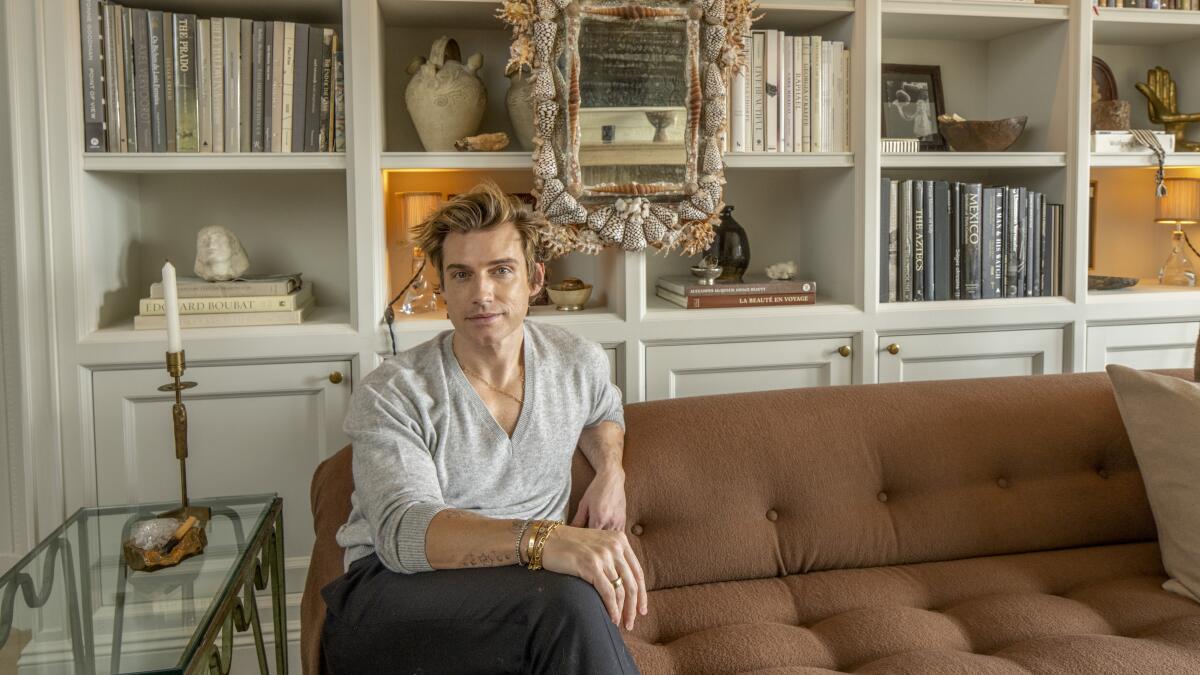In a public library, styling a bookshelf is easy: Just fill it with books. At home, a bookcase needs to do a lot more than hold books.
So how do the pros do it?
Start by thinking of your shelves as a kind of 3D wallpaper that adds visual interest to a room. The things you choose to display should express your personality.
“It’s like a little cabinet of curiosities,” said , an interior designer and the newest cast member of Netflix’s “Queer Eye.” Your bookshelves, he added, offer “an opportunity for people to look in and see where you’ve been and where you’re going.”
In the New York City home he shares with his husband, Nate Berkus — a much-photographed space featured in Brent’s new book, and often seen on , as well — the bookshelves in the den are always changing. But they’re usually filled with stacks of favorite design books, photos of loved ones and pieces of art made by their children, Poppy and Oskar.
“It’s about having fun and playing around with different ways to layer things in and tell your story,” Brent said. Here’s how he does it.
Choose your favorite books
Stuffing your shelves completely full of books can look great, especially in a home library. But if you want to mix in objects, art and photos, you may have to pick and choose which books to display.
Start by choosing ones with good-looking covers. “We try to keep the colors coordinated in groupings,” Brent said, hastening to add: “We also try to keep them within their category: art, history, décor, jewelry or whatever it may be.”
Well-worn paperbacks and other less attractive books can be stored elsewhere. In Brent’s home, cabinets with doors at the bottom of the bookshelves hold the overflow.
Stack them up

Start by choosing books with attractive covers, and use coordinated colors within individual stacks.
(Tony Cenicola / The New York Times)
Don’t line up your books in endless rows. Instead, try building stacks.
“There are things we do that really help” to create a collected look, Brent said, “like mixing books horizontally and vertically.”
When you’re adding a horizontal stack to a shelf, “usually, piles of three or more feels nice,” he said. Also, “think about mixing different heights.”
On some shelves, Brent may stack lots of books to create a stepped pyramid that fills the space. On others, he may use only a few to create a pedestal for other objects.

Brent uses books to create pedestals for objects he and his husband, Nate Berkus, collect while traveling.
(Tony Cenicola / The New York Times)
Add objects that mean something
Your bookshelves shouldn’t resemble something out of a catalog: Forget about displaying anything impersonal, even if it looks nice. This is the place to show off things you have collected over many years.
“We’ve got artifacts that my husband and I have collected since we met,” Brent said. “Everywhere we go, we pick up pottery or funny little sculptures. We’ve got tassels from curtains in old homes that we’ve kept and laid across books. We’ve got feathers that my daughter grabbed. It’s a mishmash of everything that we find beautiful, or an expression of somewhere we’ve been.”
The goal?
“The existential step I have for people,” Brent explained, “is to try to figure out a way they can incorporate their past and present, but still leave room for the future.”

Brent and his husband, Nate Berkus, frequently adjust the objects displayed on the shelves in their den.
(Tony Cenicola / The New York Times)
Create balance
Once you’ve selected most of the books and objects you want to display, you’re still only halfway there.
Now, Brent said, “you’ve got to play around with balance and scale.”
The goal is to spread the pieces across the shelves equally — mixing tall and short, light and weighty objects — so you don’t end up with some sections that looked stuffed while others feel emptier.
“If you’ve got a shelf that’s heavy with books,” Brent suggested, “lighten it up with some objects next to it.”
Even for design pros, he said, “there are no rules.” Balance can be achieved only through trial and error.
“It only really happens,” he continued, “when you get up there and play with it.”

The wall of shelving in interior designer Jeremiah Brent’s den holds an evolving collection of items that have special meaning. The key, he says, is to find a way to incorporate the present and the past, but also leave room for future treasures. “There are no rules,” he said.
(Tony Cenicola / The New York Time)
Hang interesting pieces on top
For the ultimate layered look, use picture hangers to mount one or a few special pieces of art on the front of the bookcase.
“I love to hang art on the face of the bookshelf,” Brent said, “so it almost feels like things are spilling out.”
And not just framed artwork: Sometime he’ll adorn a bookcase with other pieces, like ceramic beads or a mirror finished in shell.
“I love the organized chaos of a bookshelf that spills over with story,” Brent said.
McKeough is a freelance writer. This article appeared in The New York Times.

